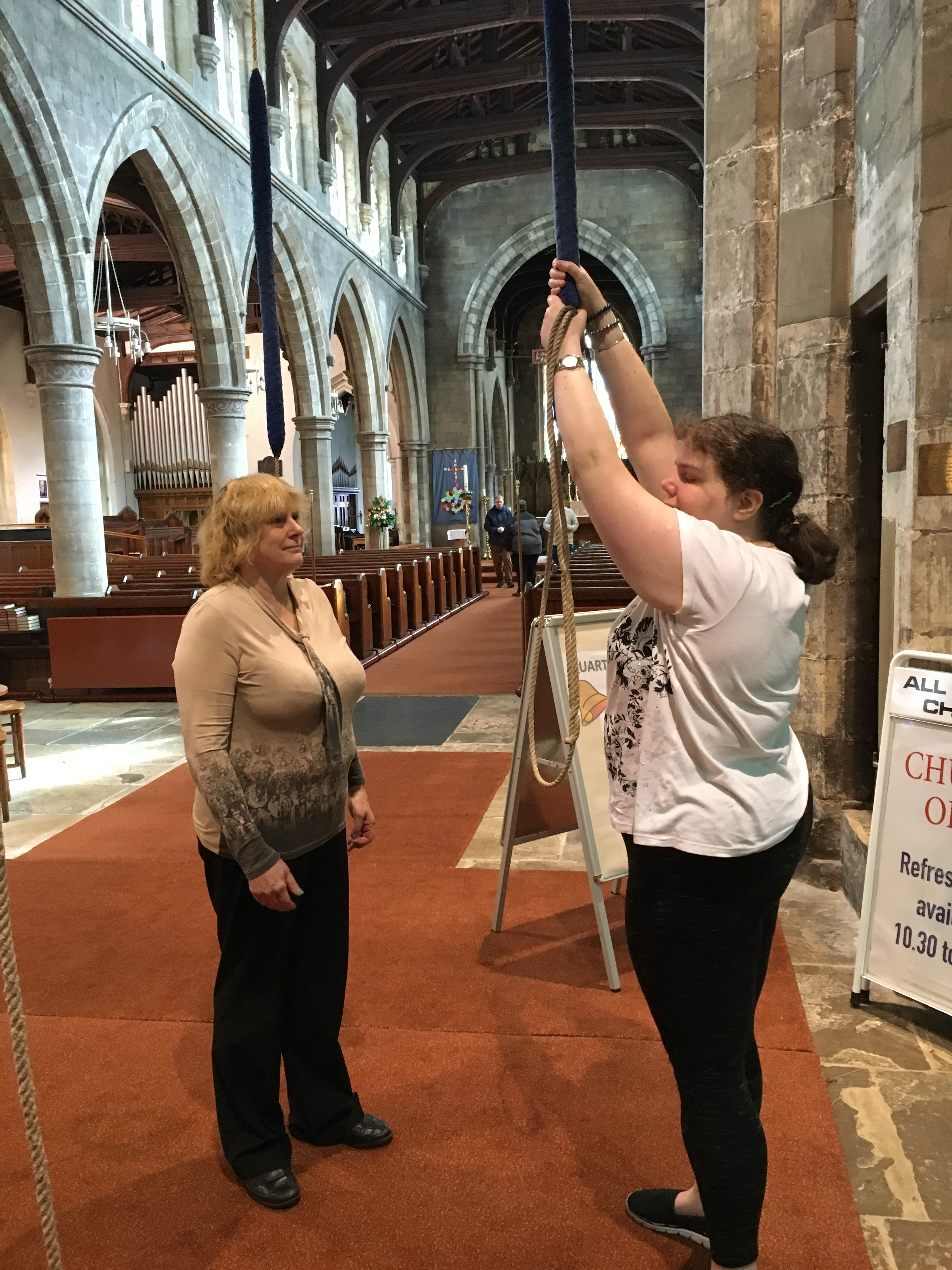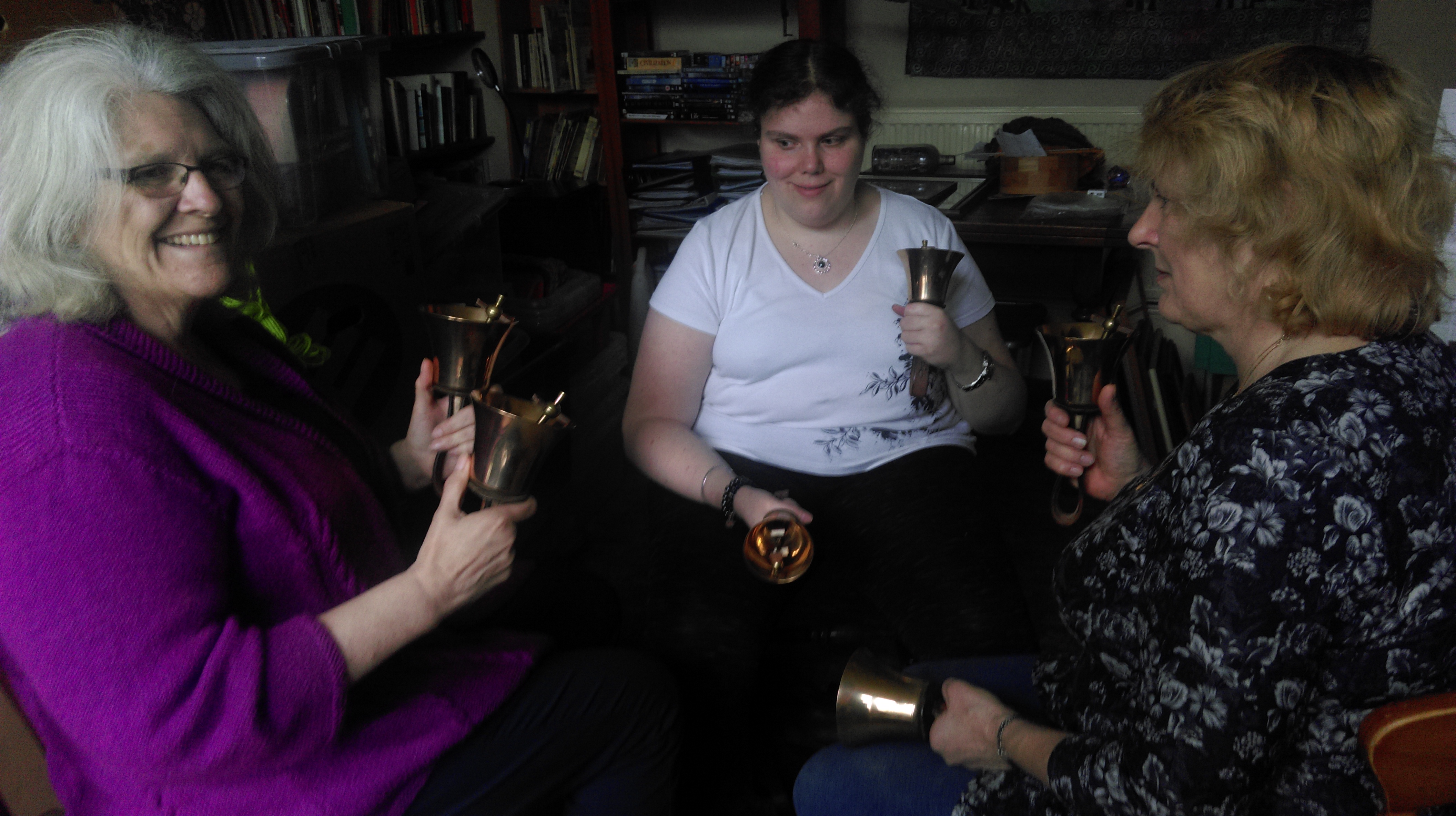Teaching Rebecca to ring
Although a ringer for many years, I didn’t have the confidence to teach anyone to ring until after I had attended an ART Module 1 Course, becoming accredited in November 2016.
About a year later I was contacted by the ART Administrator, who had received an enquiry from someone in the area. Rebecca, who has been totally blind from birth, had attended a session on bell ringing run by a local ringer at the Hull and East Riding Institute for the Blind and was interested in learning to ring. After speaking with my mentor, and with her encouragement and support and the promise of help from two ringers at our church, I agreed to teach Rebecca. After an initial chat on the phone, it wasn’t long before she had her first lesson at our tower. As a ground floor ring, Hessle did not present any accessibility problems. However, it has a long draught, over 60’ of rope – not easy for any learner, let alone one who can’t see the ropes. But I hadn’t anticipated Rebecca’ s determination and enthusiasm.
Most of the techniques and tips for teaching any learner were relevant, but some clearly were not. No trip up the tower to see the bells. Instead we are fortunate to have a large model bell in a raised frame which Rebecca could use to feel the parts of the bell and understand the difference between up and down and handstroke and backstroke. Learning to ring on a tied bell also wasn’t an option. Fortunately, our Vicar was happy for us for us to ring open and we didn’t get any complaints from the neighbours. Being able to hear the bell is a must. There was one time before Christmas when we arrived for a lesson to find that the local junior school had changed the time of their Christmas Carol Service rehearsal and were practising in Church. After a few minutes, we admitted defeat and did more theory instead.
On the Thursday before Christmas, Rebecca came to our practice night. Whilst sitting listening to the ringing, she noted that “the ringer on the 5 keeps clashing and the ringer on the 3 is sometimes slow at backstroke” – I wish some of our local ringers had the same listening skills!
Perhaps the most difficult thing was handstrokes alone. Anticipating when to try to catch the sally when not seeing it come down and bob is very difficult, particularly if the timing of the backstrokes is not absolutely consistent. We addressed this initially by putting a box underneath the rope so that Rebecca could hear when the rope hit the box. Whilst this was partially successful, it had the drawback of a potential hazard for the learner and helpers to trip over. Next, and more successfully, we tried the backstroke ringer (me) saying “now!” as I pulled off the backstroke, whilst another ringer stood beside Rebecca and controlled her wrist, and then later her elbow, guiding her when to move her hands to catch the sally. However, it soon became clear that it was easier for Rebecca if she had control of both the handstroke and the backstroke together (perhaps earlier than I would have introduced both strokes together with other learners). All I needed to do was to be there to catch the sally, in case the rope didn’t come down where she anticipated. Rebecca must be heartily fed up of hearing me say “long straight pulls” and “no fishing” (bend the elbows!) - very important with a long draught.
In January, Rebecca and I started going to another tower on their practice night – a ring of six with a much shorter draught where one of the experienced ringers had previously taught a visually impaired ringer. The challenge there for Rebecca is access to the ringing chamber, but once there, she proved more than equal to the bells, ringing in rounds on six with assistance.
Rebecca has also started to learn change ringing on handbells and is making excellent progress,
Peter Church writes:
Rebecca contacted me separately with a view to learning change ringing on handbells, and my first reaction was that handbells is a big enough challenge as it is without attempting it purely by ear, but having asked around I was sufficiently encouraged to meet with Rebecca to ensure we had a shared understanding of her aspirations.
On our first interview I explained the basis of change ringing, and she could almost immediately transpose the rows to Plain Hunting on 4, and then on 6. Isolating a single bell and defining the places it strikes in did not present a problem, and it quickly became apparent that Rebecca has extraordinary powers of concentration.
So, the obvious teaching aid is Handbell Manager and Abel. On a first introduction she managed plain hunting on one simulated handbell on 4, 6, and 8 bells. Ringing a coursing pair on 6 bells from 1 and 2 to the back presented no problem, but turning them round and hunting down proved harder. However, Rebecca’s immense desire to succeed and a few words of advice helped to overcome that hurdle. Opposites pattern was little obstacle, 2-3 pattern needed more persistence.
Encouraged by the rapid progress we installed Handbell Manager and Abel on her laptop, cleaned up the Abel options to present only Plain Hunting and Plain Bob on even numbers.
It also became apparent that most ringing aids use graphical information, but Rebecca cannot access information in that format. Consequently, some documents have been rewritten in text only and this has proved helpful.
A first attempt at ringing changes on physical handbells marked another step forward. Once the ergonomics of lining up the movement of the bell with the clapper had been overcome Rebecca was able to ring the three hunting patterns on 6 bells within the first lesson. The ringing had good rhythm including the open handstroke leads, and we now have every confidence that she will progress to ringing two bells to Plain Bob Minor in the near future.
Rebecca had a break from tower bell learning to ring in February and March as my husband and I were on holiday and she had some personal priorities. However, thanks to my mentor and others having recorded sections from Steve Coleman’s books (with his permission), Rebecca was able to continue her learning of understanding of bell ringing in the meantime. In her first lesson after Easter it didn’t take her long to get back to where she had reached before. She’s well on her way to completing her LtR Level 1 and it won’t be long before she becomes a valued member of her local band.


Ros Baxter